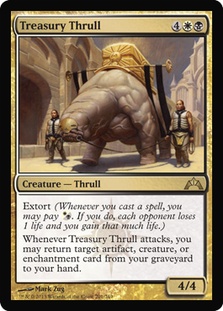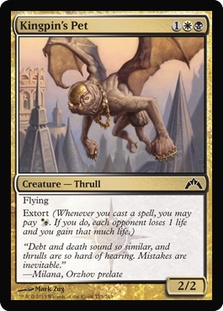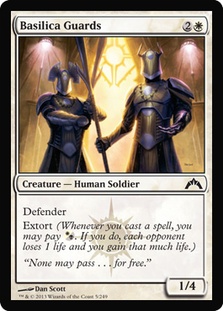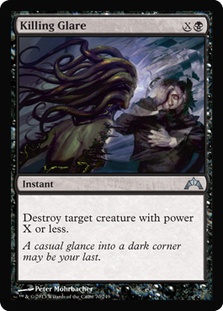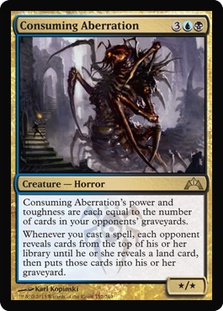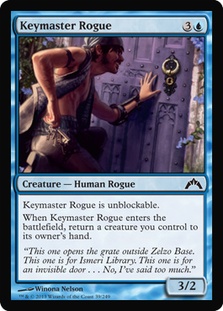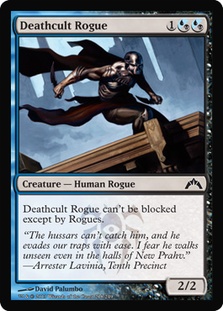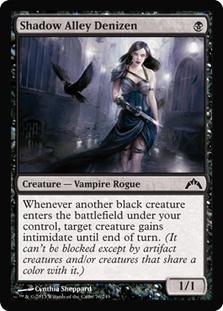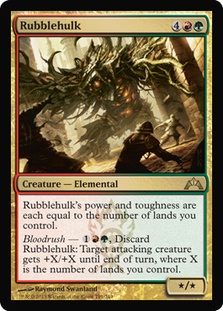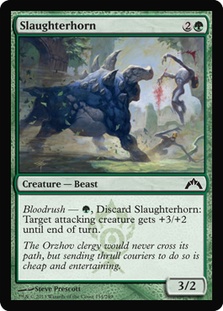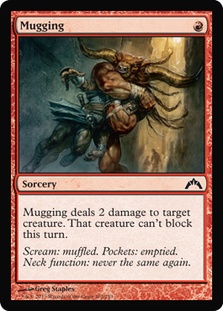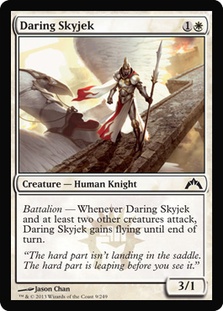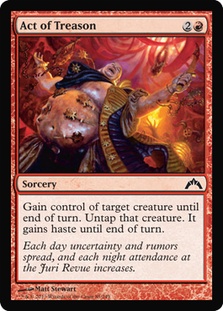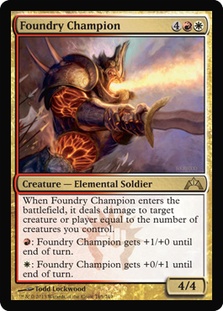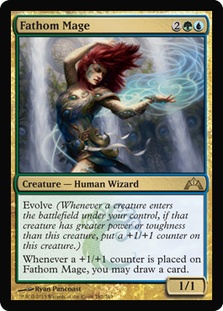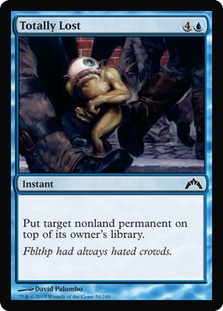Unless you’ve been living under a rock, you probably know that this weekend is the Gatecrash Prerelease. Prereleases are a lot of fun. They’re the first chance for everyone to play with all of the new cards and a great opportunity to get the hang of the set that will make up the new Draft format—not to mention pick up a few choice cards for your Standard deck!
If you’re anything like me, though, “fun” and “winning” are pretty closely related. While I don’t go into a Prerelease with the same mentality as a Pro Tour, I do like to do some thinking ahead of time about the format and what to expect. Frankly, I just can’t help myself. So I thought I’d share with all of you my thoughts on Gatecrash Limited so far based on looking at the complete spoiler, including how I think each of the guilds will play out and what to look for when you’re playing them.
The Orzhov Syndicate

On the surface, the Orzhov mechanic looks pretty insane. In a lot of Limited formats, the ability to drain your opponent for one every time you cast a spell would be absolutely ridiculous. Creatures like Basilica Guards and Knight of Obligation would be incredible—solid blockers that help stall the game out while you nickel and dime your opponent to death.
From the looks of it, though, Gatecrash is going to be a significantly more aggressive format than those in which such cards would be dominant. Sitting back and trying to stall out the ground is a troubled strategy when you’re playing against Simic and their ever-growing army of evolvers, and Boros and Gruul have battalion and bloodrush to help break through your defenses. Cipher doesn’t inherently discourage you from building up your forces, but it does lend itself toward a focus on evasive creatures, which makes playing for a ground stall less appealing than it otherwise would be.
That said, extort still seems like a powerful mechanic. It just seems like one that needs to be used more aggressively than one might otherwise like. My inclination is that Orzhov may be better served playing a relatively aggressive strategy, getting in for chunks of damage early on with cheap creatures and then using extort as more of a finisher than a primary game plan. Draining your opponent for each spell you cast is much more powerful when you’ve already gotten their life total low and each point matters that much more.
Keep in mind that you can pay extort costs multiple times for the same spell if you have more than one creature with extort in play. This makes the mechanic fit well in a deck with a lot of inexpensive cards since you’ll be able to pay the extort costs of your spells more easily. If you have three extort cards in play, you can drain someone for three with a two-drop, while you may only be able to afford to pay one time for a more expensive card. That leads me to believe that decks with a high density of extort may want to have lower curves in order to get more value out of the ability, which also leads to the desire to be more aggressive.
The Orzhov Prerelease card caters much more to a control strategy, however. Treasury Thrull is the ultimate in grindy value cards, Regrowing a permanent every time it attacks. Still, it’s also a fine top end for an aggressive deck with a lot of extort effects since it can provide you with fuel to keep draining your opponent out. It’s possible that the presence of the Thrull in every Orzhov deck will be enough of an excuse to push them all into the direction of control, but I’d be wary of trying to play a traditional long game. At first glance, the format seems ill suited for it.
One of the best commons for Orzhov seems to be Kingpin’s Pet. As a 2/2 flier with extort for three mana, it provides a solid evasive body that can serve as early pressure in an aggressive deck or a finisher in a more controlling deck. Syndic of Tithes and Basilica Screecher both seem like the sort of cards you’d want backing it up if you’re on the aggro plan, while Basilica Guards and Dutiful Thrull are more the control bent. Other commons to look out for include Grisly Spectacle and Killing Glare for either strategy, both of which seem like solid removal spells for any deck that can cast them.
House Dimir

Dimir is a hard guild for me to wrap my head around by just looking at the spoiler. Cipher is a mechanic that is hard to evaluate without playing with it because its power level is so incredibly dependent on game states. The design for the guild in general in the set seems somewhat disjointed, with a handful of cards that care about milling and the graveyard, then a bunch of cipher cards, and then typical blue and black stuff.
One of those cards that care about milling is the Prerelease card: Consuming Aberration. The Aberration is, like much of the rest of the guild, hard to evaluate. My inclination is that the Aberration is actually quite powerful. If it stays in play for any extended period of time, it can win the game pretty much on its own by incidentally milling your opponent. Unlike many similar cards from the past, however, the Aberration is actually a substantial threat on its own.
The problem that many mill effects have had in the past is that they essentially do nothing until they win the game. For some of them, like Sands of Delirium and Jace, Memory Adept, they’re so powerful that they’re worth having little to no game impact outside of winning the game in a few turns. For others, like Glimpse the Unthinkable, Tome Scour, and the like, they’re only really worth playing once you have a certain density, and even then you have to draw enough of them to win while still being able to keep control of the game.
Consuming Aberration is unlike any of these cards in that it’s actually a big body that also happens to mill your opponent out—while getting bigger in the process. It can attack and block and win you the game that way, or when the board is stalled it can just sit back and watch while your opponent runs out of cards. I expect the Aberration will be quite underrated come Prerelease time when it’s realistically a pretty big draw toward playing Dimir.
As for the rest of the faction, it’s hard for me to say. Cipher seems extremely powerful if it works reliably. That means that Dimir decks will place a premium on reliable evasion creatures, particularly inexpensive ones that allow you to get your cipher spells online quickly. Creatures like Cloudfin Raptor, Keymaster Rogue, Metropolis Sprite, and Deathcult Rogue seem like key cards for a deck that wants to play a lot of cipher cards.
Looking through the spoiler, there really aren’t as many cheap fliers in blue and black as one might expect in a typical set, so you may need to look for other ways to get your creatures through. If you have enough cipher, you may even want to look at playing cards like Shadow Alley Denizen, but I’d likely shy away from going down that route if you can avoid it—my guess is that you’d be better off trying to cut down on your cipher cards rather than digging quite that deep. Maybe even something like Skygames could be worth a shot?
In general, though, I’d avoid investing too heavily in cipher. While Gatecrash doesn’t seem to have a ton of cheap removal, you’re still risking a lot if you encode multiple spells on the same creature. Most cipher spells are costed such that they’re only really worth it if you get at least one extra use out of them by connecting with the encoded creature and only start to become a really good deal if you can hit twice. Avoid casting your cipher spells into a bunch of untapped mana on your opponent’s side of the board until you have a really good sense of what tricks they might have to stop you.
The Gruul Clans

Gruul smash! While I’ve been unimpressed by a lot of Gruul’s offerings for Constructed, I certainly can’t say the same for Limited. Gruul’s mechanic, bloodrush, is downright incredible for Limited. One of the biggest problems that an aggressive deck can suffer from in Limited is drawing the wrong mix of creatures and tricks. A hand with just creatures can get brick walled by an opposing fatty, while a hand with all tricks can’t do anything at all.
Bloodrush is the perfect solution to that problem since all of your creatures with bloodrush double as spells! I’m a big fan of the mechanic, both in terms of flavor and mechanical execution. I really like the fact that bloodrush creatures give their exact stats and keyword abilities—it gives the feeling of the creature actually leaping out to join the battle. I also really like the fact that bloodrush can only be used while attacking. The defending player has a lot of natural advantages in Magic combat, and bloodrush helps even the score.
The Gruul Prerelease card feels a lot like Carnival Hellsteed did for Rakdos last time—a somewhat clunky curve-topper for an otherwise extremely aggressive guild. Rubblehulk seems to me like the least impressive of the Prerelease cards. Gruul wants to SMASH! Not sit back and build up lands to play a big creature that doesn’t even have trample. I have a feeling Rubblehulk will see play more as a finisher via his bloodrush ability than as an actual creature. Once you can play him, you have six land in play, which makes him more or less a Might of Oaks, so you’re mostly going to want to use him as a combat trick rather than as a big dopey creature.
Unlike the other guilds, Gruul doesn’t seem like it has particular needs when it comes to putting together a solid deck. Mostly you just want solid creatures with a decent selection of them having bloodrush. Slaughterhorn jumps out at me as the common Bloodrush creature that’s likely to be the best, but there’s a lot to be said for having access to a wide variety of them so your opponent has more trouble anticipating what to play around. You’ll definitely want to look out for quality removal spells like Mugging and Homing Lightning, but don’t go out of your way to fit spells in your deck. You could actually play 20+ creatures and get away with it because of bloodrush.
While Gruul is certainly straightforward on the surface, I anticipate that it will be a very challenging guild to play optimally. Bloodrush means that all of your creatures are essentially modal cards, which gives you a vast number of options every turn. Should you bloodrush your creature in hand to save your creature in play? Should you play your bloodrush creature to increase your board presence or save it in case your opponent plays a big creature you need help breaking past? These and other questions will come up constantly while playing Gruul in Limited, making it very much the thinking person’s beatdown deck. I for one am excited for it.
The Boros Legion

When are they going to change their name to the Rietzl Legion? Anyway, Boros, like Gruul, looks at first glance to be a straightforward “turn all your guys sideways” guild, but my guess is that battalion is going to make things much more interesting than that. Battalion is a lot like metalcraft in that you’re going to want to go to great lengths to ensure you can keep it on. It’s kind of funny that both of them are R/W mechanics—I suppose those two colors are the ones that like the number “three” the most.
Unlike metalcraft, though, battalion never runs the risk of getting yourself blown out if your opponent has a trick in the middle of combat. Since it’s a triggered effect on attacking, your opponent can’t use a removal spell to turn it off once you’ve committed to the attack. This makes a card like Darin Skyjek much more reliable than Auriok Sunchaser was—not to mention the fact that the Skyjek counts toward battalion himself, so he only needs two other pals to help him compared to the Sunchaser’s reliance on three artifacts.
If you’re playing Boros and have a decent number of Battalion creatures, you’re going to be less inclined to trade in combat than you otherwise might be. You’ll certainly rarely want to be blocking, and you even might want to consider refraining from attacking in situations where your opponent is likely to block and trade. Similarly, if you’re playing against Boros, you might want to consider trying to keep the board as clear as possible in order to keep your opponent from enabling battalion, especially if they have some of the more powerful cards with the mechanic. It’s definitely worth making a somewhat unfavorable trade to keep something like Firemane Avenger or Ordruun Veteran from getting online.
Key cards you’ll be looking for in Boros are things that allow you to keep attacking with multiple creatures, as well as things that can enable battalion quickly so you can start attacking with your more powerful creatures earlier in the game. Skyknight Legionnaire seems like an excellent card for Boros. It’s a generically good creature as a 2/2 haste flier for three, and it also helps turn on your battalion creatures when your opponent might not expect it.
The aforementioned Skyjek seems like one of the better common battalion creatures because your opponent isn’t likely to be able to block and kill it and turn off battalion. Similarly, Wojek Halberdiers seems excellent—both are three-power two-drops, which is pretty sweet to begin with, and both have battalion abilities that make it difficult for your opponent to stop them once they’re turned on.
Martial Glory seems like an excellent combat trick, especially paired with the Halberdiers—being able to give your first striker +3 power while giving another creature +3 toughness is sure to make your opponent regret how they blocked. If your deck is sufficiently aggressive, even a card like Act of Treason could be excellent—take an opposing blocker and help turn on your battalion creatures all at once!
The Boros Prerelease card, like that of Gruul, seems aimed more at providing a finisher to an otherwise fast deck than a centerpiece of what you’re trying to do. Foundry Champion does key off of the number of creatures you have in play, so it’s perfect for those games in which you’ve reached a stalemate that you can’t break through with your battalion creatures. It’s certainly nothing to sneeze at, and I’m sure it will end quite a few games this weekend with a big burst of damage to the face. It’s not nearly as exciting to me as some of the other Prerelease cards, though, particularly the one of the Guild we’re about to discuss…
The Simic Combine

And now we reach the guild that I’m going to be representing this weekend: the Simic! While I typically have more Gruul sensibilities when it comes to Constructed tournaments, Simic represents all that I want to be doing in the Prerelease this weekend. Evolve is the most exciting of the five keywords to me because it’s so open-ended. If you play an Experiment One on the first turn, who knows how big it will get!
Fathom Mage is also far and away the most exciting of the Prerelease cards in my opinion. It’s the cheapest of them mana-wise, so it’s likely to get involved in the most games—except maybe Rubblehulk, who can be bloodrushed for one less. And as the game progresses, Fathom Mage not only gets bigger, but it lets you draw more cards to find more cool stuff to play. What’s not to like? Card advantage plus a potentially huge body all in one!
Evolve is an interesting mechanic in terms of both the game play decisions it involves and the deckbuilding considerations it brings up. Because evolve triggers off of playing a creature with either higher power or toughness than the creature in play, it encourages you to play creatures with highly polarized stats, meaning creatures with very high numbers in either power or toughness but not the other. Some evolve creatures fit this naturally, like Adaptive Snapjaw and Elusive Krasis, but you’ll want to fill out your deck with creatures with similar stats. You’d rather have a 3/1 like Drakewing Krasis than a 2/2, for instance, because it’s more likely to cause your creatures to evolve.
The core common cards for Simic decks will be the cheap evolvers, like Cloudfin Raptor, Crocanura, and Shambleshark. You’ll want to surround them with a supporting cast of creatures that will cause them to get bigger as frequently as possible, and for that you want those creatures with polarized stats.
Simic, like Boros, is happier sitting around and letting the game progress than trading off creatures early. It’s less of an issue for Simic generally speaking because it’s only the evolving creatures that Simic particularly cares about, while Boros gets extra value from anybody that sticks around. Like Gruul, Simic has to think twice before playing out a new creature on the board because every creature you play represents potential +1/+1 counters on other evolve creatures that you haven’t drawn yet. It’s worth keeping in mind whether the board presence gained from committing another creature to play is worth the potential cost to future evolvers, particularly if you have highly evolve reliant creatures like Elusive Krasis in your deck.
There doesn’t seem to be a huge number of great common spells for Simic—just things like Hydroform and Rapid Hybridization that are only conditionally effective. The best common spell is probably Totally Lost, which wins awards for both “Least Spell-like Name” and “Silliest Looking Creature in the Art.” Much like with Gruul, Simic is probably best off focusing primarily on assembling a solid creature base—you’ll probably want to dip into some of the green Bloodrush creatures like Slaughterhorn to give you access to combat tricks while maintaining a good creature density to keep your evolve cards working consistently.
I could easily see Simic decks playing something like eighteen creatures without a problem since poached bloodrush creatures and evolve give you the equivalent of spell effects without having to play that many spells. Who needs spells when your one-drop can get bigger than your opponent’s six-drop?
Anyway, that’s it for this week. Hope all of you going to Prereleases this weekend have a blast. I’ll be spellslinging at Thou Shalt Game in Temecula, CA, so if you’re in the area, come by and battle me. And if you have any tips for the Prerelease that I didn’t cover here that you want to share with other readers, post them in the comments—I can’t imagine that I covered everything before I’ve even played with the cards!
Until next time,
bmk

